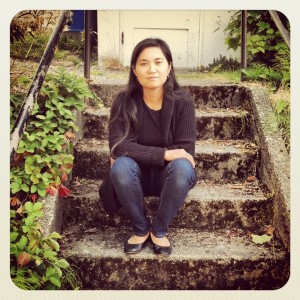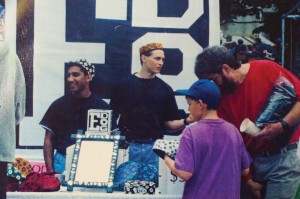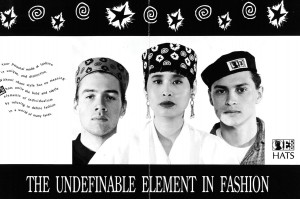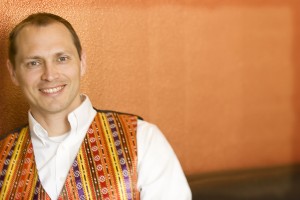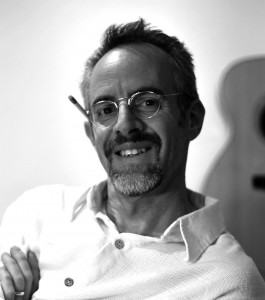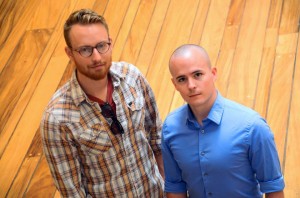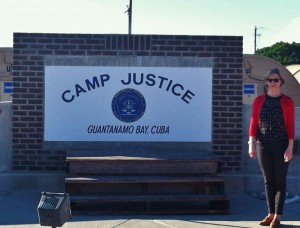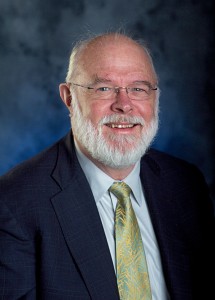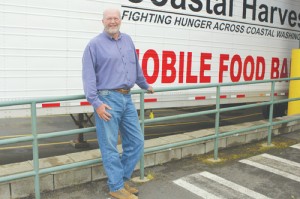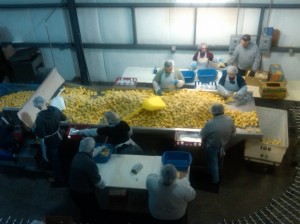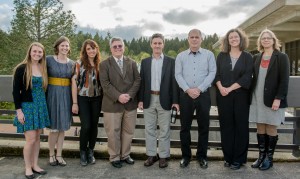On August 12, 2014, Washington State Governor Jay Inslee announced the appointment of four new ArtsWA board members, including Mariella Luz ’00. Continue reading
Category Archives: Greener Stories
Eben Greene ’91, Designing For Change
Eben Greene ’91 quickly became a familiar face at Evergreen. Perhaps most famous for his South African pillbox inspired hats and t-shirts, Greene started his first business, E-Dog Clothing, as a student. While E-Dog didn’t grow far beyond Evergreen, Eben Greene has owned his own business ever since.
Eben grew up in Yellow Springs, Ohio, and came to appreciate the reformist ideas of Horace Mann, the first president of local Antioch College. Greene describes Mann’s philosophy as a guiding factor in deciding to apply an environmental scholarship to attend Evergreen. Greene credits his mother’s health and wellness business in Ohio as a motivating factor in studying promotion. It may also have been his grandfather, the commercial artist responsible for the Yellow Pages “Let Your Fingers Do The Walking,” who was his first introduction to the power of graphic design.
Right away, Greene got involved with Earth Day and balanced courses like Health: Individual & Community with an Individual Learning Contact to learn how to manage an art design business. After graduating, Eben leased space for E-Studio, the name of his first marketing and graphic design business. Moving away from merchandise to graphic design, Greene leased a space in the iconic Security Building in downtown Olympia, across from the Harlequin Theater. Green participated in traditions like Arts Walk, and used the space above Mix96, one of Greene’s first clients and at the time an upstart effort by two Evergreen graduates. It was during Arts Walk that he met fellow alumni Pablo Shugurensky, who he credits for getting his first booth at Seattle arts and music festival Bumpershoot; Shuguresnky was also a collaborator on a line of 24 greeting cards. Greene became entrenched in the Olympia community, and many of the clients and the network he created in three years of business in Olympia have stayed with him to this day.
Eben’s career went in a different direction three years after graduating during a trip to Oregon’s Breitenbush Hot Springs, where he met a representative from Nike, who got his foot in the door at Brooks Sports in Seattle. Eben developed a strong (and enduring) portfolio at Brooks Sports, creating logos still in use today. But it was satisfaction from working with his independent clients, including ones from Olympia, that prompted the decision to focus on his own business and leave Brooks Sports in 1996.
Green’s business has changed names a few times over the years. Just recently, Eben Design became United Creations, which Greene describes as more than a marketing and graphic design company. Instead, he describes it as a change agency, uniting brand culture to help companies market smarter. Greene’s philosophy “Be You More” is a way for people and organizations to more fully realize their vision, voice, and values. Greene has been doing organizational development work as part of the branding process for years, and perceives that’s where other companies are headed.
Despite having worked with clients including Washington State Ferries, Bartell Drugs, AT&T, Google, Microsoft, Haggen, and the City of Olympia, Greene cites the 2008 recession as a time that all designers struggled as companies cut back. Things are picking up again for United Creations, but that doesn’t mean Greene will expand his company. Instead, the vision for United Creations is to build relationships and work with socially and environmentally conscious companies and organizations.
 Eben sees the power of leveraging culture to build brands for his clients. To that end, his company will launch their own “positive brand for change” in the coming year. One of the concepts Greene is most excited about is one he conceived soon after he graduated Evergreen. He credits a financial planning class providing the necessary boredom to start thinking about the symbols people identify with, like the Peace Sign. Ever since, Greene has been motivated to develop symbols for people’s values. United Creations has developed forty two of what they call ValYou symbols, which will be first displayed at this year’s Bumpershoot festival. Which do you connect with most? Soon, Greene predicts that will be a common question.
Eben sees the power of leveraging culture to build brands for his clients. To that end, his company will launch their own “positive brand for change” in the coming year. One of the concepts Greene is most excited about is one he conceived soon after he graduated Evergreen. He credits a financial planning class providing the necessary boredom to start thinking about the symbols people identify with, like the Peace Sign. Ever since, Greene has been motivated to develop symbols for people’s values. United Creations has developed forty two of what they call ValYou symbols, which will be first displayed at this year’s Bumpershoot festival. Which do you connect with most? Soon, Greene predicts that will be a common question.
Recruiting Veterans is Personal for Ty Somerville
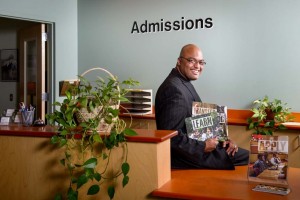
Tyrone (Ty) Somerville is an Evergreen Admissions Counselor specializing in Veterans and Evening and Weekend Studies. Photographed in the Admissions department on Mon., Dec. 23, 2013.
Tyrone “Ty” Somerville joined the Office of Admissions at Evergreen in November 2013 and was immediately confronted with a difficult yet personal challenge: overcoming the negative impression of the college. Ty is familiar with those misconceptions because he faced them himself when he decided to transfer to Evergreen as a student and 11 year U.S. Army veteran from Green River Community College.
When Ty talks to prospective students at Joint Base Lewis McCord, no one understands the difficult decision to enroll at Evergreen more than he does.
“My recruiting efforts revolve around exposing our service members, their families, and veterans to the great community we have here at Evergreen. It is my duty and privilege to present The Evergreen State College to some of the greatest people who have sacrificed the most in service to this country.”
Evergreen regularly recruits and distributes literature on the military base, but they are faced with competing against schools that offer associates degrees. According to Randy Kelley, Director of the Veterans Resource Center at Evergreen, that’s exactly what service members and veterans are instructed to pursue. The prospect of pursuing a liberal arts education goes against the advice of many career counselors in the military, who see an education at technical colleges as a more direct line to employment. This makes Ty’s job even harder- not only does he have to sell Evergreen, but he has to sell the value of Liberal Arts.
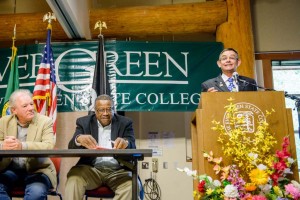
Director of the Veterans Center Randy Kelley talks about the history of medallions in the armed forces at the Welcome Reception for Veterans and Veterans’ Dependents on Fri., Sept. 27, 2013. The reception ended with the presentations of an Evergreen Veterans Medallion to each of the veterans present. From left to right: Daryl Morgan, Thomas (Les) Purce, Randy Kelley
But Ty doesn’t have to do it alone. Daryl Morgan, one of at least seven members of the faculty who are veterans themselves, teaches a specially designed program called “Veterans’ Next Mission: Crossing the Bridge Between Military and Academic Life.” This course specifically helps students transition into Evergreen and understand the value of their transferable skills from military service.
Somerville describes the Veterans Resource Center, under the leadership of Kelly, as “a resource and support hub for those who utilize The Evergreen State College, supporting them in ensuring that achieving their educational goals isn’t an insurmountable task. That support is provided in various ways and the information regarding the proper resources for obtaining the support can come in many different fashions.”
The Veteran’s Resource Center employs student workers, veterans themselves, and guides students from the admissions process through graduation and beyond. The Veteran’s Resource Center works collaboratively with staff across the institution to bring support services under one roof, and works with external organizations like the VA to ensure students have access to all benefits available.
For Somerville, while he knows Evergreen isn’t for everyone, it’s gratifying to connect with non-traditional students and show them the opportunities of getting their four year degree at Evergreen. Somerville himself is on track to graduate in the winter. Like many veterans, he’s a hard worker and is working full time while finishing school. So when he talked with a student with an A.A. earlier this year working at a drive-through, he felt confident as he walked him through the application process for Evergreen Tacoma and showed him a Bachelor’s Degree is possible.
If you are an Evergreen alumni and a veteran, service member, or dependent, please complete this survey to help Evergreen better serve you.
Read coverage of the Veteran’s Resource Center at northwestmilitary.com
Listen to Randy Kelley, Ty Somerville, and other veteran students in this video produced by Veterans for Peace
Seth Frankel ’93 Designing Museums for Peace Around the World
Few stories are harder than the stories Seth Frankel ’93 designs and develops into exhibitions for museums across the country. As principal of his Colorado-based exhibition design firm, Studio Tectonic, he’s developed wide ranging exhibits. He’s created exhibits on watersheds, paleontology and beer (the beer and paleo exhibits aren’t the same, by the way, but he claims eyewitness account that there’s plenty of beer in paleo field camps).
But of the exhibits he develops, few are as challenging as the telling of human atrocity, genocide and healing. Some tell of recent events, such as his work creating the national Sierra Leone Peace Museum that wrestles with the nearly unspeakable genocide ending in 2002. Others are centuries old, such as the Civil War era Sand Creek Massacre of Arapaho and Cheyenne peoples in the Colorado Territory.
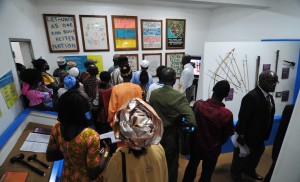
At the Sierra Leone Peace Museum, visitors look at the causes of the nation’s 1991 to 2002 civil war and how they connect to healing, rebuilding and promoting a continued peace.
“I strive to tell a balanced story. I use artifacts, media, visuals and narrative to provide the complexity of these human events in ways that the visitor can’t turn away from. It’s easy to dehumanize history’s perpetrators, but ultimately if we allow the richness of experience to grow in the visitor’s mind they’re engaged – not as observers but as partners in the humanity.”, says Seth.
In his twenty years of working with museums he’s seen significant growth in the relationship between storyteller and visitor. “Museums of the past, and many of our still standing older exhibits, have great objects and may be quite successful in disseminating facts. Who doesn’t enjoy seeing wonderful, powerful things?”, he asks. “But facts are quickly forgotten or replaced with new details. Building experiences, and our participation in creating and sharing these experiences, are very much at the center of the new museumship.”
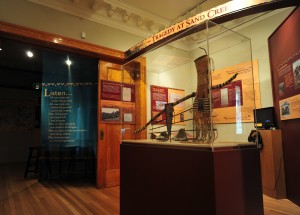
Chief Niwot ~ Legend and Legacy exhibit the Boulder History Museum in Colorado challenges visitors to look at past atrocities against native peoples and asks them to consider their place today in relationship to this past.
Seth has observed changes also in the expectations of the public. Many of his exhibitions feature creating learning environments in which the visitor can both leave their mark for other exhibit goers and to the broader world through social media. In thinking about the importance of museums for promoting peace, Seth takes this work very personally.
“We commemorate and tell of horrible pasts…hopefully arriving at overcoming these horrors to arrive at decency and celebration of human compassion. Yet, we’re seemingly programmed to look for a happy ending. But peace museums aren’t about an ending…they’re about building the capacity to envision a future. One that can only exist through connecting ourselves to the breadth and range of the human condition. Our good. Our bad. Our forgotten. Our remembered.”
Want to see Seth’s work in person? Check out the list of exhibitions by Studio Tectonic and see if there’s one in your area.
Todd Slind ’92: Global Entrepreneur
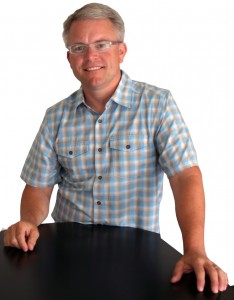 Todd Slind ’92 is a Northwestern family man. He has been sighted taxiing his children around Ballard on his bicycle/pedi-cab and loves sailing and snowboarding in his spare time. But when Todd discovered that a friend and colleague from Trinidad had been killed last fall in the Westgate Mall terrorist attack in Nairobi, he related, “I’d always identified myself as someone from the Northwest, a native and very rooted here, but I realize that I feel like a global community member since I got that news.”
Todd Slind ’92 is a Northwestern family man. He has been sighted taxiing his children around Ballard on his bicycle/pedi-cab and loves sailing and snowboarding in his spare time. But when Todd discovered that a friend and colleague from Trinidad had been killed last fall in the Westgate Mall terrorist attack in Nairobi, he related, “I’d always identified myself as someone from the Northwest, a native and very rooted here, but I realize that I feel like a global community member since I got that news.”
Although he treasures his time at home and is an active member of his local community, Todd spends a lot of time traveling the world for SpatialDev, his geospatial analysis business. From Seattle to India, Todd has developed apps and programs that help governments, organizations and people. At Evergreen, Todd says that he learned to be a self-directed social problem solver and how to focus on details while keeping the big picture in context. In his work, he often uses and expands on these skills. For example, a mobile app he helped develop provides information on local invasive species while one of his programs provides web mapping of continuously updated agricultural survey information on farmers in India.
During Todd’s recent trip to Burkina Faso, a west-central African country with a large rural population, he had another awakening. With the mindset of a western man from a “developed” country, he was expecting to discover a depressed and impoverished population hungry for commercial development. Instead, he found a largely rural population that appears to be satisfied with the sustenance they provide for themselves and the little luxuries gained from sales of their modest harvests. He was also impressed by their adoption of International Women’s Day as a national holiday. From his original skepticism, Todd has become a Burkina Faso fan.
Evergreen is well represented by this smart and flexible global-community Northwest native alumnus.
CommitChange Aims to Transform Non-Profit Fundraising
Roderick Campbell ’10 and Jay Bolton ’11 never crossed paths while at Evergreen, but with more than $700,000 in seed investment from the likes of Mark Cuban and Tim Draper, this odd couple has taken internet startup CommitChange to the Major Leagues of Silicon Valley.
Roderick described the way he came to partner with Jay as an “arranged marriage” by Merchant OS, now a part of LightSpeed Retail. Merchant OS was a client of Roderick’s small web development business, which helped Campbell pay for school. Fatefully, Jay was an intern with the company at the same time. To this day, Roderick and Jay still remember the offer of a year’s salary to do whatever they wanted, as long as it was with each other, as the most bizarre offer they’ve ever received. But that’s when the seed of CommitChange was born.
While Roderick and Jay are business partners now, they took vastly different paths to where they are today. Roderick was a theatre student at Evergreen, studying with faculty like Sean Williams, a big influence for Roderick. While a student, Roderick was the Assistant Director of local theatre fixture Harlequin Productions. Roderick took advantage of travel opportunities while he had them, traveling to 32 countries, and spending two to three months abroad every year since high school.
Meanwhile, Roderick describes Jay as “the smartest guy he’s ever met,” even in the one of the world’s leading hubs for high tech innovation and development. Jay studied computer science at Evergreen, and Roderick described him as a person who can “learn a new computer programming language in a weekend; someone who can build anything.”
When they started working together, under contract with the booming Merchant OS, they keyed in on an app which allowed consumers to pay rent online. Several months into their work, they had something of an ‘aha’ moment and went back to the drawing board. Their goal: a billion dollar company that could help a billion people. Otherwise, they might as well work for Google, Campbell conceded.
They came up with an idea for supporting non-profit philanthropy efforts. The reason: Roderick estimates that over 2 billion people on the planet are directly impacted by non-profits. When they performed an environmental scan of the products and services available for non-profit development, Campbell described an industry stuck using old technology and widespread lack of innovation. With the fees companies levy on non-profits for online fundraising, Roderick discovered it is often less efficient than using direct mail! CommitChange aspires to develop a product for non-profit philanthropy in the way that Linkedin is the product for professional networking. With the right technology and product at the right price, they believe non-profits will move more of their fundraising efforts online.
While Roderick and Jay are far from where they were when they first started CommitChange on the top floor of the Evergreen Plaza Building in downtown Olympia, Roderick insists Evergreen is “the most underrated school in the country” and is hopeful to hire Evergreen students as his company grows in the years ahead. Roderick Campbell and Jay Bolton are definitely two young alumni worth watching for.
Read more about Roderick and Jay in The Olympian, linked here.
Alex Stupple ’00 Reports On GTMO Trial
When Alexandra (Alex) Stupple ’00 was offered the opportunity to observe a pre-trial hearing at the Guantanamo Bay prison detention camp, she jumped at the possibility. Stupple was nominated by her law school professor, who was also then-president of the National Institute of Military Justice (NIMJ), the NGO responsible for sending her as a trial observer. Stupple didn’t know what she was in for, and with the hearing date continually postponed, she wasn’t sure if it was even going to occur. But finally, last February, Stupple boarded a military plane to Cuba for the chance of a lifetime, where the alleged perpetrator of the suicide bombing of the U.S.S Cole in Yemen was standing trial. The experience, which Stupple reported on with only ten other NGO observers, was mentally somewhat of a struggle. Stupple recalled:
“Everything was so contradictory. Beach bars and barbed wire. Secret roads. Gift shops with ‘I heart GTMO’ merchandise without even a sense of irony. We stayed in MASH-style tents, with one for men and one for women. There was another tent surrounded by barbed wire. They wouldn’t tell us what it was for.”
What might have been most difficult for Stupple were not the accommodations, but the fact that “the hearings themselves weren’t as blatantly unfair as [she] imagined they would be.” Stupple described a place where nothing was black and white, clear cut, or totally fair. In Stupple’s eyes, “the law strives for fairness and ways of dealing with conflict without violence. The problem with the GITMO situation is that we did resort to violence.” But sorting out these questions is something Stupple is well equipped to do.
Alex Stupple described her Evergreen experience, where she focused on American Studies, as where she “learned how to think.” While attending the Hastings College of Law at the University of California, Alex came to appreciate her Evergreen education more. She views the traditional model of education as “a ridiculous way to learn,” and recounted one class at Evergreen in particular, with David Marr, where she was tasked with the challenging assignment of “writing one perfect paragraph.” When she arrived at law school after spending ten years as an English teacher in China, then as a science editor in Scotland and in D.C. working for the National Academy of Sciences and the American Journal of Public Health, she wondered what traditional colleges actually taught students. Since Alex’s law school experience, she concedes Evergreen has “since been dear to my heart” especially during three and a half hour exams that comprised 100% of her class grades.
Alex is an Attorney for the California Department of Public Health in Sacramento and in her spare time is “still obsessed with international and military law.” You can read more about the significance of her experience to observe the pre-trial hearings at Guantanamo Bay in her other proud alma mater’s news release.
“Terry Oliver ’73: Saving the World One Kilowatt Hour at a Time”
Winning the “Oscars of Bonneville Power Administration (BPA),” officially known as the Administrator’s Excellence Awards Program, is a big deal at the Portland, Oregon-based nonprofit federal agency. BPA is in the energy marketing business, and Terry Oliver ’73 has been leading and directing research and development there for decades. Receiving the Administrator’s Meritorious Service Award is an acknowledgment of a career built on Oliver’s mantra: “Saving the world one kilowatt hour at a time.”
After trying everything from grassroots organizing with the now-defunct Citizens for Solar Washington to land-use planning and even working in a Minute-Mart, Terry Oliver has worked for BPA since 1981. He also took “maybe the world’s longest period of leave without pay” from BPA (from 1992 to 2000), during which he served as the Managing Director of the International Institute for Energy Conservation in Bangkok, Thailand, and worked on sustainable energy issues in the Middle East, South Africa, and throughout Asia.
Oliver studied International Relations at Evergreen, a school he chose as a community college transfer student because of its coordinated studies, and he heard it was a place to “combine things into interesting puzzles.” Evergreen was where he “learned how to learn,” which Oliver calls “the key theme” of his career. Of his “leave-without-pay” experience, Oliver recounts that he “picked up some of what I learned from a U.S. context and something from Evergreen… [getting] to recombine things in an interesting way.” When he started at BPA, managing programs like the Hood River Conservation Project was only going to be a three-year job. But with groundbreaking success on a global scale, even when Oliver returned from leave, coming back to work at BPA “was like putting a familiar shoe right back on. It was a good fit.”
In 2005, completing the circle, Terry Oliver was named BPA’s first Chief Technology Innovation Officer, responsible for energizing, focusing, and managing BPA’s research portfolio. Since then, he has restarted the BPA’s R&D program and created a publicly articulated research agenda, shifting its philosophy to “Copy people like Apple or Boeing who do R&D, not because it’s a hobby, but because it’s vital to their business.” When asked if he’s figured out the formula for success, Oliver laughs, replying, “That’s what they finally wrote up the award for!”
With such honors as this award and being named a Fellow by the Portland International Center of the Management of Engineering and Technology, Terry Oliver is able to confidently say his work “has actually delivered value to BPA.” In the R&D world, that is “a really big deal.”
Anthony Airhart ’00 Takes On Hunger in Coastal Washington
When Anthony (Tony) Airhart ‘00 arrived at Coastal Harvest in 2010, he reflects that the Hoquiam Washington based organization “was simply screaming for a collaborative, multi-dimensional, creative set of solutions to organizational woes—it needed to have someone question why things were done as they were—to look at everything with a critical view. Someone who knew how to work across boundaries and barriers to build consensus and coordinate a path forward.” Coastal Harvest started out of a pickup truck more than 25 years ago. It now delivers as much as 4 million pounds of food a year for more than 54 agencies (food banks and feeding programs), all for free, in seven counties across Southwest Washington.
Tony’s path to becoming the Executive Director of Coastal Harvest was a long, winding road that took him from “cog in the wheel” at Weyerhaeuser to where he is today. Tony attended Evergreen’s Grays Harbor Reservation-based AA Degree Bridge program, graduating at 45 years old with a bachelor’s degree in community leadership in 2000 . Although he originally enrolled while working, a facility closure at Weyerhaeuser meant he was out of a job after nearly 31 years. With his degree and experience from Evergreen, Tony got the opportunity to direct the small nonprofit, which has 6 employees, many dedicated volunteers, and an enormous daily impact.
Tony insists “the Evergreen learning style and methodology is a perfect fit in the nonprofit world. The ability to work with diverse groups and communities and having excellent communication skills are very important.” He describes the foundational role of interdisciplinary studies in preparing an executive director to wear many hats, juggle priorities, keep learning, and become proficient in a broad spectrum of topics, all while working for a diverse board of directors and with staff and community members. For Airhart, this means that “all of this information must be filtered, absorbed and analyzed, then placed against the needs, priorities, and mission of Coastal Harvest before making decisions.” In the big picture, Airhart reflected that his “years at Evergreen prepared [him] to face these challenges”.
It was a long and unexpected road for Tony Airhart, but he eventually found his passion at an organization that clearly needed a Greener.
The Living Tradition of the Rachel Carson Forum
The Rachel Carson Forum is one of the oldest traditions of Evergreen’s Graduate Program on the Environment offering the Masters of Environmental Studies (MES) degree, now approaching its 30-year anniversary. The event was established in 1990 as a tribute to Rachel Carson, a marine biologist and writer in a time when it was almost impossible for women to pursue careers as scientists. While Carson wrote several well-known books, such as The Sea Around Us and Our Ever Changing Shore, her legacy is largely tied to her groundbreaking book, Silent Spring. While the science of the environmental and human effects of pesticide application was outside her area of expertise, the book’s bold and impassioned arguments started inspired conversation and debate that helped spark the environmental movement of the 1960s.
The Rachel Carson Forum has always been organized by students of Evergreen’s MES Program. The current organizing group, the Masters of Environmental Studies Student Association (MESA), put together the 2014 panel featuring two amazing Evergreen alumni, Rhys Roth ’90, an MES graduate and Director of the Evergreen Center for Sustainable Infrastructure, and Thera Black ‘92, Senior Planner for the Thurston Regional Planning Council (TRPC). The panel also featured Richard Fealy, Senior Scientist for the National Oceanic and Atmospheric Administration (NOAA) and Nobel Prize recipient, and Andy Haub, Planning and Engineering Manager for the City of Olympia. Such an incredible group of guest speakers has come to be expected of the Rachel Carson Forum; the event has featured true giants of the environmental community, such as the late Billy Frank Jr. and mycology pioneer Paul Stamets ’80, in recent years.
Martha Henderson, Director of the MES Program, started the conversation on April 24 by recounting the lasting legacy of Rachel Carson in helping convey and rally people to complex environmental issues through strong science and communication. The panel members perfectly exemplified that mission, and the mission of the Rachel Carson Forum’s founding faculty, who Henderson conveyed, “wanted to provide images of environmental action.” Henderson emphasized that the event wasn’t just for students, but that is was “a service of MES to the broader community.”
MES leadership has always represented that philosophy, including the likes of Oscar Soule, Ralph Murphy, John Perkins, Tom Rainey, Richard Cellarius, and now Martha Henderson. Henderson’s term as director will end in late August, when she will return to teaching full time; she will take a group of students to the eastern Mediterranean region in Spring 2015. In talking about the MES Program, Henderson recalled it traditionally as a home for “Environmental Refugees” from across the country. While today’s graduate students have many schools where they may pursue a Masters in Environmental Studies degree, Evergreen’s MES program has adapted to changing times. It has three prongs of study: Climate and Energy Studies, Ecology, and Community Sustainability. Approximately 70% of the program’s students are women, an important focus of Henderson’s work as MES Director. Another important issue is global climate change, which Henderson believes will inform a shift in the focus of MES to “to help us understand alternative ways to have constructive relationships with the environment.”
Hopefully, the Rachel Carson Forum can help students, and the broader community, do just that, for the next 30 years and beyond.


